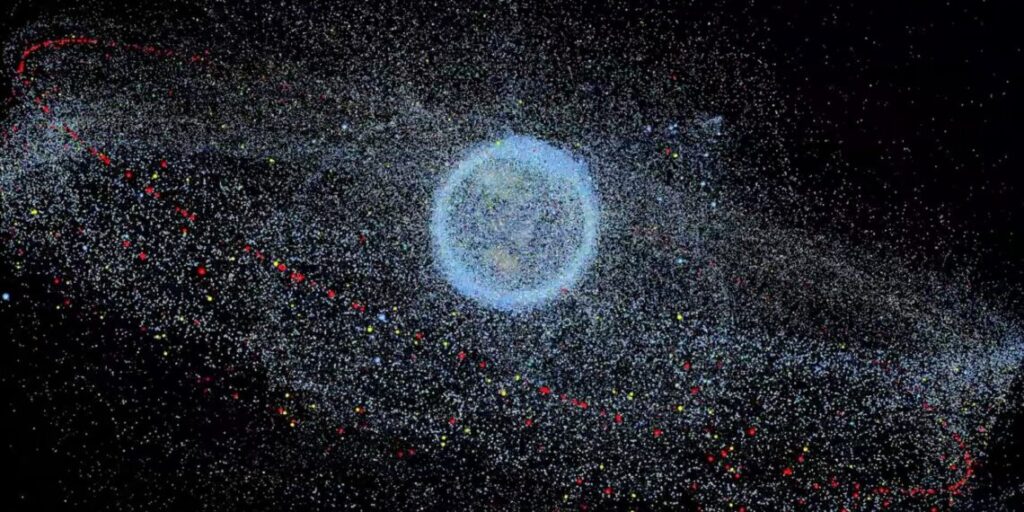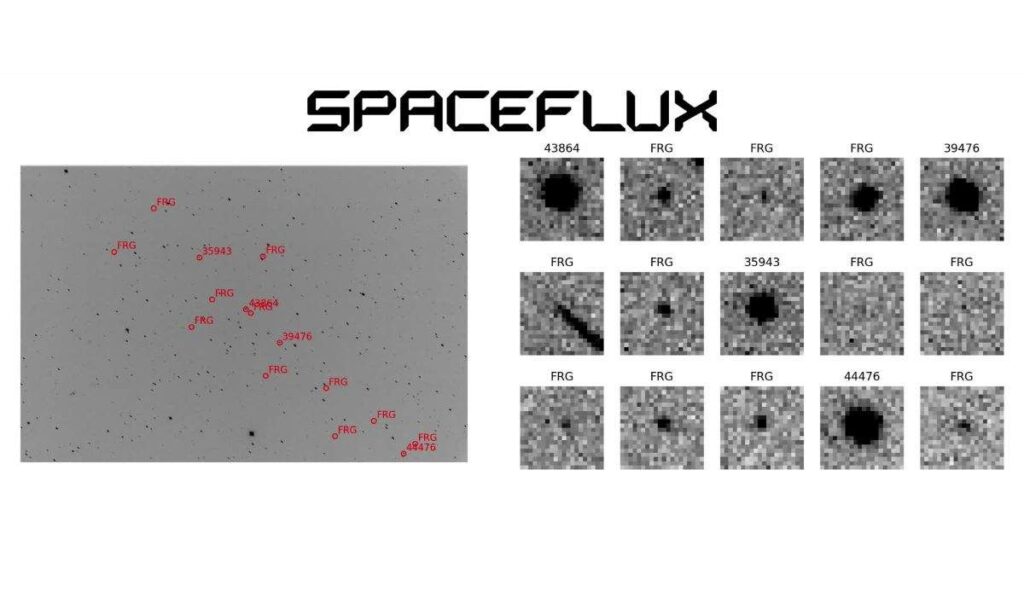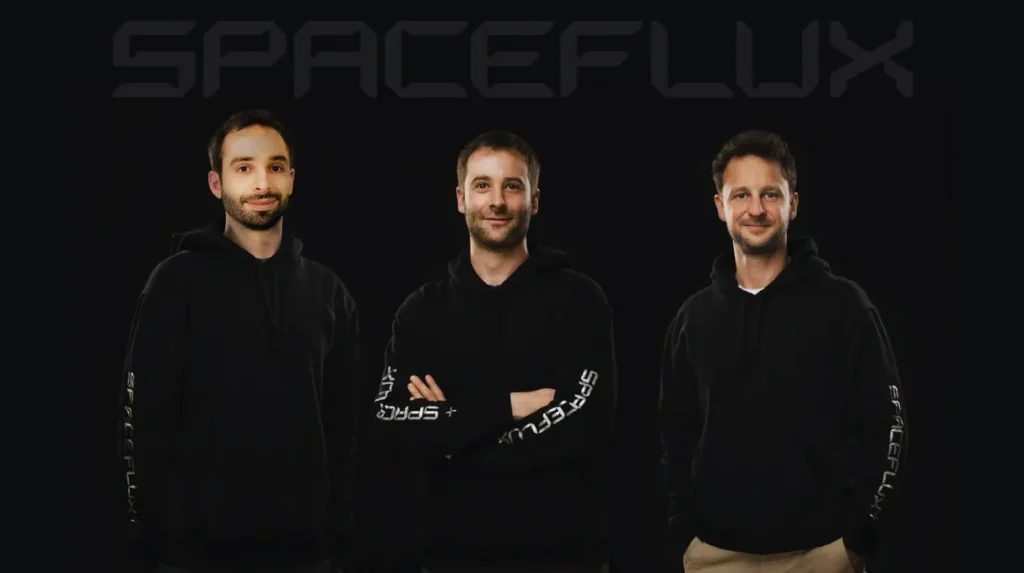Why observe and study space debris? Interview with Mentore Giorgetti from Spaceflux
Note for the reader: This article has been translated from Italian into English. Here is the link to the original article published on June 19, 2025 by Astrospace and written by Stefano Piccin.

Distribution of space debris. The red line represents the geostationary orbit. Each white dot shows the actual position
(not the actual size) of a piece of space debris that has been tracked so far.
There are currently over 11,000 satellites orbiting the Earth, but if we also count artificial objects no longer active such as old satellites, pieces of space debris, or even waste—millions of objects larger than one centimeter are being tracked. These all pose significant challenges to satellite operators, especially now that increasingly large mega-constellations are being built.
Today we speak about this with Spaceflux, a UK startup focused on tracking, measuring, and studying space debris. We reached out to Mentore Giorgetti, Managing Director of Spaceflux Italia, to ask him about the importance of tracking and studying this debris and to announce the opening of the company’s Italian branch, officially presented in May 2025.
Let’s start with the overall picture: How crowded is Low Earth Orbit today, and what are the main consequences of this congestion?
The lowest orbits, particularly Low Earth Orbit (LEO), are undoubtedly the most crowded today. Being closest to Earth, it’s also the easiest and cheapest to reach. This has led to impressive growth in this orbital band. However, precisely because of its proximity, available space is more limited compared to Medium Earth Orbit (MEO) or Geostationary Orbit (GEO).
LEO is crowded with a vast satellite population, destined to grow exponentially. China alone plans to launch tens of thousands of satellites with just two mega-constellations. Adding Amazon’s Kuiper constellation into the mix, the picture becomes clear: space density will keep increasing, not to mention the trend already started by Starlink.

Debris from the Intelsat 33e satellite observed and tracked by Spaceflux telescopes.
Then we must consider debris: from old, defunct satellites launched as far back as the 1960s, to components generated during every launch, like explosive bolts used to separate rocket stages (debris that remains in orbit for years, even if rarely mentioned). Even a single fragment can be potentially lethal when traveling at 28,000 km/h. A notable example was the ISS being hit by a paint chip just one centimeter wide several years ago, nearly penetrating a pressurized module.
This triggers the so-called Kessler Syndrome: each impact creates new fragments, leading to further collisions in an exponential cycle. NASA estimates there are over 25,000 objects larger than 6 cm, half a million objects between 1 and 2 cm, and hundreds of millions over 1 mm.
Tracking these objects is critical: it prevents collisions, protects missions, ensures astronaut safety, and is fundamental because space has become essential for everyday life on Earth, even if many people aren’t aware of it yet.
Thus, better tracking and effective regulations are essential. Do you think these are the two main pillars, or are other tools needed?
Regulation is crucial but cannot depend on individual countries alone. If one country behaves sustainably but others don’t, the problem remains. Doing things properly is costly, often prohibitively so. Without a shared regulatory system and an oversight body (similar to air traffic control), good practices remain isolated.
This involves security, not just military, but economic as well. A satellite broadcasting video content, for example, has significant commercial impacts. Clear, uniformly enforced rules are needed. Otherwise, it’s like telling someone with high cholesterol to “change their lifestyle” without providing a treatment or mandating adherence.
Another issue is the current model: many small satellites with short lifespans quickly re-enter but meanwhile crowd LEO. Do you think this approach might exacerbate the situation before we find concrete solutions? And if so, is tracking still the solution?
It’s a paradox: affordable access to space enabled many new companies and solutions. If space access reverted to being exclusive to a few governments, we’d lose this innovation drive.
A key issue is the lack of global obligations. For instance, many operators rely solely on Space-Track, a system operated by the U.S. Space Force. But Space-Track isn’t sufficient: it generates thousands of false alarms, its propagation models are imprecise, and it lacks updated information on maneuvers or classified assets.
Two years ago, Kuiper project managers told us they anticipated thousands of false alarms daily for that constellation alone. This makes the current situation unsustainable.
There’s also the cost factor. Today, young companies like ours can offer precise data at more affordable costs, something impossible just five years ago. Optical sensors, for example, are significantly cheaper than radar stations and perform better in higher orbits. The main barrier remains the high launch cost for satellites placed into these orbits.
Let’s step back: could you tell us how Spaceflux started and what you do?
Spaceflux was founded in 2022 in the UK, aiming to make space safer. We deal with Space Situational Awareness (SSA) and Space Domain Awareness (SDA). SSA is more commercially oriented, while SDA has stronger defense implications.
We provide data and analytics to prevent collisions and protect space infrastructure. Our detailed services primarily target governmental and commercial clients: we observe and track everything visible in real-time across all three Earth orbits, identifying even non-cooperative targets.
Our network comprises proprietary optical sensors distributed globally—15 already operational and 10 more being installed. All observatories are company-owned and managed directly. Our strength is the combination of a proprietary sensor network and analytical capability, backed by an AI platform that processes and delivers data to clients within 90 seconds.

The founders of Spaceflux. From left to right: Prof. Ingo Waldmann, Chief Technology Officer;
Marco Rocchetto, CEO; Marcel Debczynski, Chief Commercial Officer. Credits: Spaceflux
Have you also developed sensors capable of daytime observation?
Yes, in collaboration with the UK’s Defence Science and Technology Laboratory, we developed a SWIR (Short-Wave Infrared) sensor operational during the day. This significantly expands observational coverage, making Spaceflux the exclusive supplier to the UK government for GEO.
Our research and development division, Spaceflux Labs, also works on predictive algorithms and models to detect objects smaller than traditional radar limits.
Another ongoing project is a system for automatic anomaly detection: when an object behaves unexpectedly, we increase observation frequency to understand its nature and potential danger.
And what about Spaceflux Italia?
We opened Spaceflux Italia in late 2024 to strengthen our European presence. This allows us to recruit local talent, establish academic collaborations, and develop an autonomous yet integrated ecosystem with our UK headquarters. The goal is to build an independent European hub, not just a satellite office of the UK HQ.
We already collaborate with UCL in London and aim to replicate this model with Italian and European universities. Two of our founders have academic backgrounds, with experience in astrophysics and applying machine learning to space data analysis.
This is our strength: combining scientific rigor with rapid execution to tackle an urgent issue that impacts everyone.
We thank Mentore Giorgetti, Spaceflux Italia, and Spaceflux for this interview.
PRESS RELEASE – Spaceflux awarded multimillion-pound UK Government contracts to deliver sovereign Space Surveillance and Tracking
London, UK 20/11/2025 – Spaceflux Ltd, a UK-based leader in space domain awareness (SDA) and space intelligence, has won all three major multimillion-pound, multiyear UK government contracts to provide advanced space surveillance and tracking (SST) data across multiple orbital regimes. The UK Space Agency (UKSA) and the UK Ministry of Defence (UK MoD) contracts, awarded under…
The Silent Sentinel: How Space Domain Awareness is Supporting Modern Conflicts
By Kerri Mertz As conflicts on Earth become increasingly reliant on assets in orbit, the importance of space as a contested military domain has never been clearer. The war in Ukraine has underscored a pivotal shift: space is no longer a backdrop to terrestrial operations—it is a frontline in its own right. At Spaceflux, we…
PRESS RELEASE – Spaceflux secures £5.4M to accelerate its growth as a key global player in Space Domain Awareness
Leading UK satellite tracking company raises £5.4 million in seed funding to expand its global telescope network and accelerate development of AI-powered space situational awareness solutions. The company will enhance its 24/7 monitoring capabilities to serve government and commercial customers addressing increasing challenges of orbital congestion and space security. London, 25th July 2025 – Spaceflux,…
Newsletter signup
Stay informed about the latest advancements in optical space tracking, technology releases from Spaceflux Labs, and early access to new capabilities.